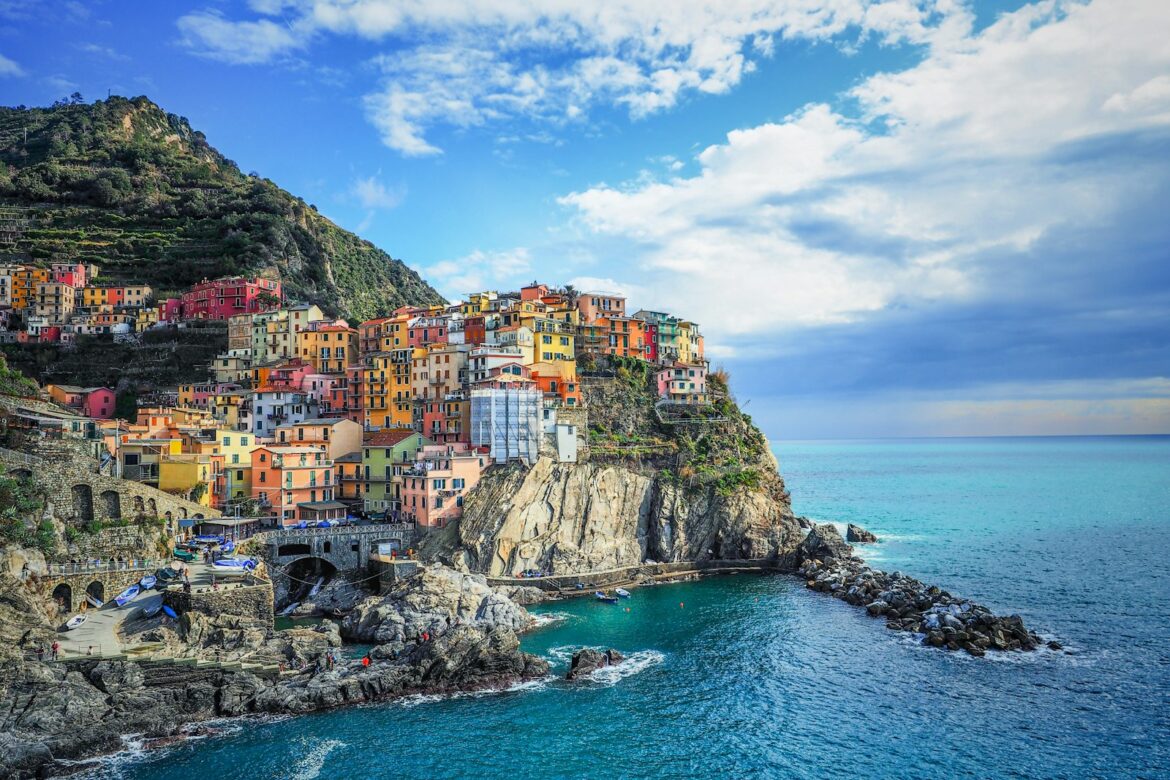This Post consists of Popular Travel Video Guides by Travellers & Relevant Open Public Historical Information and Facts about Cinque Terre to provide all Information in One Place (References: Wiki, Youtube & Others)
Public Facts about Cinque Terre
The Cinque Terre (meaning “Five Lands”) is a coastal area within Liguria, in the northwest of Italy. It lies in the west of La Spezia Province, and comprises five villages: Monterosso al Mare, Vernazza, Corniglia, Manarola, and Riomaggiore. The coastline, the five villages, and the surrounding hillsides are all part of the Cinque Terre National Park, a UNESCO World Heritage Site. The Cinque Terre area is a popular tourist destination.
Over the centuries, people have built terraces on the rugged, steep landscape right up to the cliffs that overlook the Ligurian Sea. Paths, trains, and boats connect the villages as cars can only reach them with great difficulty from the outside via narrow and precarious mountain roads.
Learn More in Detail in Rick Steves’ Travel Video Guide about Cinque Terre
Exploring Italy’s most remote and romantic stretch of Riviera, we visit five tiny port towns: dramatic Vernazza, surrounded by vineyards; reclusive Corniglia, high on its bluff; pastel Manarola; hardscrabble Riomaggiore; and the pint-sized resort of Monterosso. Fishing for anchovies, sipping wine out of rustic barrels, and savoring twinkling Mediterranean vistas, we enjoy the ultimate Riviera.
– Rick Steves’ Europe
Historical Background About Cinque Terre
Historically, Cinque Terre is mentioned in documents dating to the 11th century. Monterosso and Vernazza were settled first and the other villages grew later, whilst within the territory of the Republic of Genoa. In the 16th century, the inhabitants reinforced existing forts and built new defence towers to defend the area from attacks by the Turks.
Cinque Terre experienced an economic decline from the 17th to 19th centuries, recovering when an arsenal was built in La Spezia and it gained a railway link to Genoa. The railway led to migration from the area and a decline in traditional industries until the growth of tourism from the 1970s onwards brought some prosperity. The predominant crops in the area have been grapes and olives. Some fisherman were based in Monterosso, but the area’s gaily painted fisherman’s cottages were conceived in the late 1970s as a tourist attraction.
Best Places in Cinque Terre – A Travel Guide
Cinque Terre, translating to “Five Lands”, is one of Italy’s most visually arresting destinations — a stretch of the Italian Riviera that seems painted in sunlight, kissed by salt winds, and embroidered in a palette of pastel hues. It comprises five centuries-old seaside villages: Monterosso al Mare, Vernazza, Corniglia, Manarola, and Riomaggiore, each perched like a dreamscape above the sparkling Ligurian Sea. What makes Cinque Terre so captivating is not just the staggering coastal beauty or the cliffside homes that resemble a child’s crayon fantasy come alive, but its rooted charm — a place where fishermen still mend their nets by the harbor, nonnas bake lemon-scented pastries, and vineyards terrace the hills in geometric elegance. There are no sprawling resorts or garish nightlife districts here. Instead, you get footpaths that whisper with history, stone-walled sanctuaries, and a lifestyle that has defied time’s pushy hand. For anyone seeking an unforgettable Italian experience, Cinque Terre is not just a destination — it’s a sensorial pilgrimage through flavors, landscapes, and cultural memory.
Start your journey in Monterosso al Mare, the largest and perhaps most “resort-like” of the five villages. It is uniquely divided into two parts: the old town (Vecchio) and the new town (Fegina), separated by a tunnel but both connected by soul. What makes Monterosso truly special is its sprawling sandy beach, which is a rarity in the region — most Cinque Terre villages are known for their rocky or pebbly waterfronts. Here, you can lounge under striped umbrellas, sip local Sciacchetrà wine, and indulge in freshly grilled anchovies, a local delicacy that’s nothing like the tinned version. The Church of San Giovanni Battista, with its striking black-and-white striped façade, stands as a sentinel of Gothic-Ligurian architecture, while the Statue of the Giant, carved directly into the rock and representing Neptune, watches over the sea with stoic grandeur. Monterosso also has the best access for those with mobility issues and offers a slightly more commercial experience while still retaining that quintessential Ligurian charm.
Heading south, you reach Vernazza, widely considered the jewel of Cinque Terre. With its natural harbor, colorful cascade of houses, and steep, winding alleyways, Vernazza presents itself like a painting caught in motion. No cars are allowed here, so the sense of preservation is palpable. Climb to the Doria Castle, a medieval bastion that once protected villagers from pirate raids, and take in panoramic views of the town and harbor below — a true photographer’s dream. The Santa Margherita di Antiochia Church, built in 1318, rises proudly at the water’s edge with its octagonal bell tower, offering both spiritual and aesthetic respite. Vernazza’s tiny harbor invites you to sip espresso at a waterfront café while the sea laps at the shore and the fishing boats sway like sleepy cats in the sun. It’s a place where you feel time loosen its grip — where you can spend an hour simply watching shadows play across crumbling walls or the sunset turn the sky into liquid marmalade.
Next comes Corniglia, the most unique of the five villages because it sits high above the sea rather than hugging the coastline. Accessible by climbing the Lardarina Staircase — all 382 steps of it — or by a shuttle bus from the train station, Corniglia rewards its fewer tourists with peace, authenticity, and sweeping sea views unmarred by beach crowds. It’s the only village not directly adjacent to the water, and this gives it a more rural, introspective vibe. Its ancient terraced vineyards are some of the oldest in the region, and many say the best Sciacchetrà, the prized dessert wine of the area, comes from Corniglia’s grapes. The Church of San Pietro, a striking piece of Gothic architecture, dates back to the 14th century and boasts rose windows carved from Carrara marble. The quiet piazzas, shaded by fig trees and echoing with local chatter, feel like whispers from another century. This is a perfect stop for writers, introverts, and anyone yearning for a quiet slice of old-world Italy with views that stretch infinitely toward the horizon.
As you descend back to sea level, Manarola appears like a living fresco — the kind of place where postcards are born. It’s one of the oldest villages, believed to be founded in Roman times, and is perhaps the most romantic and photogenic of them all. Manarola’s main street runs from the train station through the village and down to a small harbor framed by rugged cliffs and the turquoise Ligurian Sea. The scene is completed by color-blocked houses stacked in cascading rows, almost tumbling into the water. One of the best activities here is walking along the Via dell’Amore or “Pathway of Love”, a short but breathtaking trail carved into the cliffs that connects Manarola with Riomaggiore. Though parts of it may be closed due to landslides, even a partial stroll offers sweeping sea views and an atmosphere thick with amorous whispers. Manarola is also famed for its nativity scene during Christmas, considered the largest in the world, glowing with thousands of lights on the hill above the village. At twilight, dine on trofie al pesto or stuffed mussels, paired with a glass of crisp white wine, as the cliffs glow like embers and the sea begins to shimmer like polished glass.
Finally, you reach Riomaggiore, the southernmost and perhaps the most authentically rugged of the five. It’s a town where local life still pulses visibly — where you can watch fishermen preparing their boats at dawn and elderly women hanging laundry from their balconies like flags of domestic pride. The main drag, Via Colombo, is lined with quaint shops, enotecas, and seafood restaurants offering acciughe al limone (lemon-marinated anchovies), seafood risotto, and creamy gelato that tastes like a scoop of summer. The verticality of the village is striking; steep stone steps wind up through the heart of the town, offering glimpses of the cerulean sea at each twist. Riomaggiore’s small marina, framed by massive jagged rocks, is the perfect place to end your Cinque Terre adventure — watching the sun melt into the sea as waves splash against the rocks and the buildings reflect golden light like living lanterns. There’s also the Church of San Giovanni Battista, built in 1340, which offers not just religious charm but also a peaceful escape from the heat and crowds.
As you traverse these five towns — each unique, yet part of a greater whole — you begin to understand why Cinque Terre is a UNESCO World Heritage Site and a living museum of Italian coastal life. Whether you’re hiking the Sentiero Azzurro trail, sampling local Ligurian dishes, lounging on hidden beaches, or simply admiring the hand-laid stonework of medieval churches, every moment here feels both ephemeral and eternal. To visit Cinque Terre is to step into a world where beauty is both deliberate and effortless, where every crag and every cobblestone tells a story of survival, community, and grace. It is not a place to be rushed — but rather a region to be breathed in slowly, tasted thoughtfully, and remembered forever.


